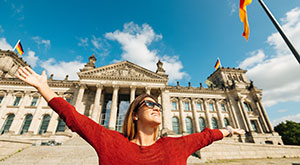Transport Options in Germany
Driving
Drivers who hold a valid licence from any EU country, as well as Iceland, Norway or Liechtenstein, may drive in Germany without time restrictions. If you hold another international licence, you can use it for between six months and a year, but then you must apply for a German licence and may have to take a written or practical test. When driving in Germany, you drive on the right hand side of the road and you must have your licence, vehicle documents and insurance paperwork with you at all times. You are also required to carry a warning triangle and first aid kit. All passengers must wear seatbelts and children under the age of 13 must sit in the back of the car.
As per its international reputation, Germany's autobahn network is well-maintained and does not charge tolls. However, its most famous feature, having no speed limit, is in fact only partially true. Many of the busier sections do have enforced speed controls, and a recommended limit of 130kph (80mph) is in place across the rest of the network. The limit on most other roads is 100kph (60mph), dropping to 50kph (30mph) in urban areas. Unlike in some countries, speed cameras may legally be hidden.
Taxis
German taxis are typically cream-coloured sedan type vehicles with yellow signs on the top. They are available in all the main cities around any airport or public location. All are required to have a visibly displayed meter and the fares are regulated by local authorities, although rates vary between different jurisdictions. Be aware that drivers are allowed to charge extra for nights, weekends, credit card payments, carrying animals or transporting luggage.
Taxis can be ordered from many German towns by dialling 22456*, there is a fee for using this service and further information can be found at DB Bahn.
Buses & Coaches
Despite the developed transport infrastructure, buses remain the most common form of public transport in German cities. Services also run frequently in smaller towns, with only rural locations short of services. In larger cities, there are often several bus companies competing on similar routes to each other.
As a highly economical and relatively comfortable way to get around Germany and out into neighbouring European countries, coach services such as Eurolines are popular with tourists and backpackers for the relatively low prices. However, for quicker journey times, the railways and air travel may be better options.
Trains
With over 40,000km (25,000miles) of track, the railway network in Germany is one of the most comprehensive in the world. The trains are modern, comfortable and usually punctual. The major operator is Deutsche Bahn. Although fares can be on the expensive side, the high-speed train services are the quickest way to travel and will take you to most of the major cities in Germany as well as several destinations beyond the German borders. Regular travellers can save money with a BahnCard or by taking advantage of advance fare offers.
Trams and light rail
Many German cities have tram systems, particularly in eastern regions. Most are fairly old systems now and are perhaps not the quickest way to travel, but they remain a popular choice with commuters who are looking to avoid traffic. Germany also has many light railway systems (S-Bahn) in operation in urban areas. These are not to be confused with the underground U-Bahn networks boasted by some of the larger cities like Berlin, Hamburg, Frankfurt or Munich. For more information on services near you, check your city or state website.
Air travel
Germany has a large number of commercial airports serving domestic and international destinations around the world. Frankfurt Airport is the main hub for the German flag carrier Lufthansa, and over a hundred airlines operate services through the airport to more than 250 destinations. Other major international airports include Munich, Düsseldorf, Cologne and Hamburg. As well as international flights, airlines operate regular domestic services between the major cities of Germany. Most are reachable in less than an hour, but time spent in the airports means that high-speed train services are often a more time-efficient way to travel.
Other ways to get around
Cycling is popular in Germany and in many cities there is a safe cycling infrastructure to encourage this eco-friendly form of transport. Sea transport is still important for freight, with large ports like Hamburg and Bremerhaven handling vast tonnage every week. A series of canals brings shipping inland and boat services on rivers, lakes and canals have become popular with tourists looking for a more relaxed way to see the country.
Max Saved Jobs Reached
A maximum of 500 Saved Jobs can be created against your account. Please remove an existing Saved Job in order to add a new Saved Job.
Manage Saved Jobs








